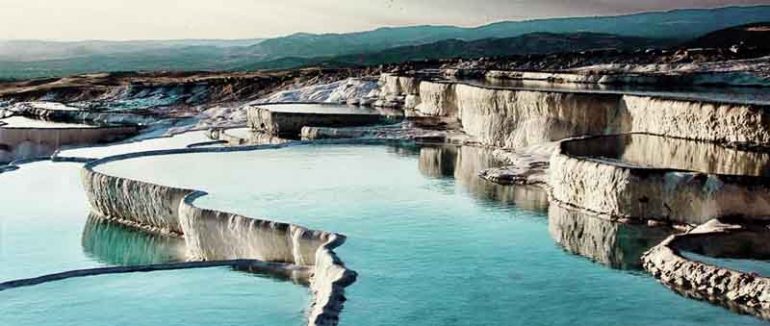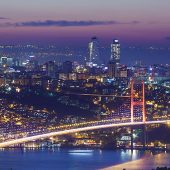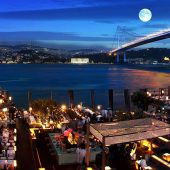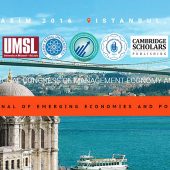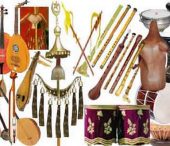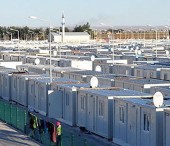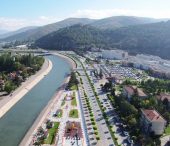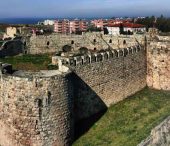Denizli is a growing industrial city in the eastern end of the alluvial valley formed by the river Büyük Menderes, where the plain reaches an elevation of about a hundred meters, in southwestern Turkey, in the country's Aegean Region.
The city has a population of about 400,000 (2006 census) and is the capital city of Denizli Province.
Denizli has achieved a remarkable economic development in the last decades based notably on textile production and exports. Having become a vibrant center of manufacturing focused on exportation, Denizli is frequently cited, along with a number of other Turkish cities, as one of the foremost examples of "Anatolian Tigers" in reference to its rapid pace of development.
Denizli also attracts many visitors to the nearby mineral-coated hillside hot spring of Pamukkale, and the ancient ruined city of Hierapolis, as well as ruins of the city of Laodicea on the Lycus, the ancient metropolis of Phrygia. Also in the depending of Honaz, about 10 miles west of Denizli is, what was, in the 1st century A.D., the city of Colossae.
The weather is very hot in Denizli in summers, whereas in winters, it may occasionally be very cold with snow on the mountains that surround the city. Springs and autumns are generally rainy.
Etymology
The name Denizli means "a locality with a sea or with a lake" in Turkish, but the town is not on the coast. The name mutated through several spellings and must have referred to the abundance of underground water sources or the city's location on the way to western Turkey's lakes region nearby.
History
The area has been occupied since prehistoric times, there were important ancient Greek and Roman towns nearby, (Hierapolis and Laodicea on the Lycus), which persisted through the Byzantine period.
The city was founded in its current location after the area has been settled by the Turks.
In the 17th century, the Turkish traveler Evliya Çelebi visited Denizli and recorded the town as follows: "The city is called (Denizli) (which means seaside in Turkish) as there are several rivers and lakes around it. In fact it is a four day trip from the sea. Its fortress is of square shape built on flat ground. It has no ditches. Its periphery is 470 steps long. It has four gates. These are: painters gate in North, saddle-makers gate in the East, new Mosque gate in the South, and vineyard gate in the West. There are some fifty armed watchmen in the fortress, and they attend the shop. The main city is outside the fortress with 44 districts and 3600 houses. There are 57 small and large mosques and district masjids, 7 madrasahs, 7 children's schools, 6 baths and 17 dervish lodges. As everybody live in vineyards the upper classes and ordinary people do not flee from each other."
The city lived in peace for centuries without being involved in wars in a direct manner. Following the World War I during the Independence War the Greek forces managed to come as close as Sarayköy, a small town 20 km (12 mi) northwest of Denizli, but did not venture into Denizli where resistance was being prepared.
Climate
Denizli is located in Aegean Region of Turkey, but the climate is not uniformly Aegean throughout the whole province. A terrestrial climate may be felt in the center of the province, because the area is like a pathway from the seaside to inland areas. The inland area is cooler than the seaside because of these climatic differences. The land is open to winds coming from the Aegean Sea because the mountains are perpendicular to the sea. Winters are rainy or sometimes snowy, but generally mild.
Denizli today
Aside its visitor's attractions, the city of Denizli is known for its textile industry and (and outlet shopping for cut-price clothing), for connected fields of activity such as the dye industry, and for its famous cockerels. The saying goes that Denizli is known for 'kız', 'toz' and 'horoz'; respectively, the girls (the girls of the Aegean Region are famously the fairest in Turkey), the dust and the cockerels. There are statues and other images of the birds all over the city. Extremely resourceful in catchy phraseologies evolving from the folk culture, the region also affirms itself by saying "Denizli'nin horozları bellidir" (the cockerels of Denizli make themselves known).
Economy
The textile industry in Denizli grew rapidly in the 1980s and 1990s making itself a place in the domestic market and for exports. Towels and bathrobes are products associated with Denizli in particular emphasis. Thus, Denizli grew rapidly in the last decades, raising a number of very rich businessmen, some reasonable to very good restaurants, notably one renowned across Turkey for serving only mushrooms in different varieties (Mantar Restaurant), and the look and the amenities of a modern city. The biggest firms in the city include Değirmenci and Funika (especially for bathrobes).
Lifestyle
The city is quite smart with trees along the main avenues and lovely views of the surrounding mountains from many locations. As Denizli has prospered in the 90s new compounds of luxury villas have sprung up on the city's outskirts in areas like Çamlık. In the city itself air pollution from coal-fired central-heating becomes a problem in winter. There are some highly-regarded high schools and Pamukkale University opened in the 1990s, now in phase of academic maturing. Many young people still leave to go to university in İzmir, Ankara or Istanbul, and sometimes stay there to build careers.
Culture and entertainment
There are large shops, bars and cafes, even some live music, although this is a city that grew recently and is located deep in the countryside. The presence of Pamukkale University improves the cultural amenities of the city. The region's inhabitants have been influenced by the production of grapes and the wine since centuries and a joyful culture is present in Denizli, although it is coupled with hard working and creative thinking, reflected in an apparent conservatism. For example, it is sometimes difficult to get a license to sell alcohol.
On the other hand, the new wealth in Denizli has been much more rapid than many other places in Turkey in investing in developing an urban culture. Many private clubs and associations are opening up including: The society for the Protection of the Environment and History of Denizli; The Poets and Poetry Lovers Association; the Pizza Appreciation Group and the Jazz-rock Local. There is an annual amateur theatre festival, attended by groups from Turkey and overseas. Denizli has the second-largest number of ranking chess-players in Turkey, after Istanbul. Also, inspired by the unusually high reports of UFO sightings in the region over the years, one of the world's handful of museums dedicated to ufology was recently opened in Denizli.
Food and drink
The wines of the Pamukkale winery are mostly made from traditional Turkish grapes such as Tokat, Narince and Çalkarası, although now they are planting Shiraz in the area too. They also make a well-known cherry wine. The Denizli kebab is roast lamb served on flat bread. Zafer Gazozu is a locally produced fizzy lemonade.
Transportation
Denizli airport is about 45 minutes drive from the city. There is direct flight almost everyday from Istanbul usually in the morning and back to Istanbul in the evening both with Turkish Airlines. The ticket would cost approximately $60.
Driving time to the capital city of Ankara is approximately 7 hours.
Driving time to İzmir is approximately 3 hours, with special alertness to be preserved at all times during the extremely busy Denizli-Aydın section. The extension of İzmir-Aydın highway to Denizli, to better benefit the production hub that Büyük Menderes River valley is, remains announced since years. Initial infrastructure is laid in Aydın, but the rest is yet to come and the present Aydın-Denizli road, although straight and flat, has a very high level of traffic, especially trucks, with each town along the road possessing its own industrial zone.
Places of interest
Laodicea ad Lycum - 6 km (4 mi) north of Denizli near the village of Eskihisar. The city was established by Seleucid King, Antiochus II in honor of his wife, Laodice. This trading city was famous for its woolen and cotton cloths. A letter written by a Laodecian says; “I am happy. I have fortune and I am not in need of anything.” Following a large earthquake which destroyed the city, what remains of the ancient city are one of the seven churches of Asia Minor, the stadium, the amphitheatre and the odeon, the cistern and the aqueduct. (see further Laodicean Church)
Hierapolis and Pamukkale World Heritage Sites -20 km north of Denizli Pamukkale traventines. The city of Hierapolis was founded by the Pergamon King Eumenes II in 190 B.C. Its closeness to Laodicea led to commercial and military rivalry. The town was built in Greek style. Despite suffering a violent earthquake in 17 A.D., it reached its peak during the Roman and Byzantine periods. It was reconstructed during the 2nd and 3rd Centuries in stone from quarries in the area, in a Roman style. The town had its most glorious years during the reign of Roman Emperors Septimius Severus and Caracalla and became an episcopal seat during the expansion of Christianity. However, as a result of several earthquakes, the most violent of which was in 1354, a great part of the town was destroyed, and its people migrated.
The Seljuq caravanserai Akhan, which is 6km from Denizli City on the Ankara highway, and a great part of which still remains, was constructed by Karasungur bin Abdullah in 1253-54 when he was acting as the commander of Ladik. It is recently restored along with the Ottoman konaks nearby and is set to become a visitor's attraction by its own right.
Honaz mountain is a popular picnic excursion for Denizli's people in summer.
The nearby village of Goncalı, which is on the railway line, is another excursion. People come to eat the charcoal-grilled thinly-cut kebab called Çöp Şiş, preferably with the local süzme yoghurt and a glass of rakı.
The statue of Atatürk at Çınar Meydanı in the city centre is renowned for the large testicles on the horse that Atatürk is riding.
Servergazi turbesi is located close to the Yenişehir neighborhood. The tomb of the 12th century Turkish commander of the Seljuk akinci unit is located there. Many locals enjoy visiting and making prayers at the tomb especially on weekends.

